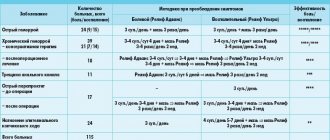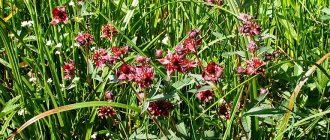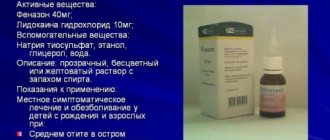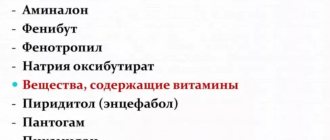Field (Equisétum arvense) and its medicinal properties
A spore plant reaching a height of 40-50 cm. The name is translated from Latin as horsetail. The rhizome is creeping and long, with small tuberous branches, the stem is smooth, the leaf teeth are collected in whorls of 6-12 pieces. On the territory of Russia it grows everywhere with the exception of semi-deserts and deserts.
More information about the structure and reproduction of horsetail can be found here.
Healing effect
Doctors use preparations containing horsetail to treat urolithiasis and kidney disease.
The power of its effect surpasses even kidney tea. But it should be remembered that medications based on it cannot be used for nephritis, since some substances are irritants to the kidneys. When diagnosing diseases such as heart and pulmonary failure, edema, horsetail helps to effectively expel excess fluid from the body and thereby alleviate the patient’s condition.
Other properties:
- it has astringent property;
- stops inflammatory processes;
- removes lead and other heavy metals from the body;
- it significantly reduces blood sugar levels;
- in small doses it has a positive effect on the reproduction of collagen and bone tissue;
It is not recommended to use horsetail in large doses.
Forest (Equisetum sylvaticum)
Place of growth: Scandinavia, North America, Central Asia, the Caucasus, Far East (swamps, ponds, forest edges, tundra and bushes). The height of the plant is about 50 cm, the rhizome is brown and small, the epidermis of the stems is covered with spines, the spikelets are cylindrical. Information about feeding qualities is contradictory. Used for dyeing fabrics.
Literature
Wikisource has texts on the topic Equisetum pratense
- Krylov P. N.
[herba.msu.ru/shipunov/school/books/krylov1927_flora_zapadn_sibiry_01.djvu Flora of Western Siberia. Guide to identifying West Siberian plants. Second supplemented and expanded edition of “Flora of Altai and Tomsk Province” by P. Krylov: In 11th issue] / With the cooperation of B.K. Shishkin, L.P. Sergievskaya, L.F. Reverdatto and E.I. Steinberg. - Tomsk: Publishing house. Tomsk Separated Rus. Nerd. Society, 1927. - T. I. Pteridophyta - Hydrocharitaceae. — P. 52-53. - [herba.msu.ru/shipunov/school/books/ledebour1853_flora_rossica_4.djvu Flora Rossica sive Enumeratio Plantarium in Totus Imperii Rossici Provinciis Europaeis, Asiaticis et Americanis hucusque Observatarum. Auctore Dr. Carolo Friderico A Ledebour, Botanices Professore emerito, Augustissimi Rossiae Imperatoris a consiliis status, insignibus muneris sine probro exsecuti ornato, ordinnm St. Wladimiri tertiae classis, St. Annae secundae classis Corona Imperiali decorat., Ludovici darmstadt. Commendator., Aquilae rubrae borussic. et Dannebrogici Equite, Academia. et Societat. litterar. plur. Sodali]. - Stuttgartiae: Sumtibus Librariae E. Schweizerbart, 1853. - T. Volumen IV. Accedit Index ad totum opus pertinens. — P. 488.
- Gubanov, I. A. et al.
31.
Equisetum pratense
Ehrh. — Horsetail // [herba.msu.ru/shipunov/school/books/gubanov2002_illustr_opred_rast_sred_rossii.djvu Illustrated guide to plants of Central Russia. In 3 t]. — M.: Scientific T. ed. KMK, Institute of Technology. research, 2002. - T. 1. Ferns, horsetails, club mosses, gymnosperms, angiosperms (monocots). - P. 105. - ISBN 8-87317-091-6.
Meadow (Equisetum pratense)
This species has erect pale green shoots, a branched rhizome and one spore-bearing spikelet per shoot. It reproduces well vegetatively, spores appear in May-July.
Prefers moist soils, deciduous forests.
Widely distributed in European countries (Ireland, Norway, Croatia, Austria, Iceland, Denmark), in the subarctic regions of North America, and in Asia. Young spore-bearing shoots can be eaten. In the taiga areas of Siberia, meadow horsetail is given as feed to horses.
Description
As soon as the spring sun shines, horsetail begins to sprout in the gardens, which is classified by our summer residents as a weed.
Horsetail likes to grow in acidic soil, this is a signal to start alkalizing the soil
The plant, which belongs to the higher spore species, has a height of 10 to 40 cm, its stems end in a spore-bearing pistil in the form of a spikelet, in which seeds - spores - are located. As soon as they are scattered, the stem dies and leaf development begins. They have a tetrahedral shape, a bright green tint, and branch well on the lower parts of the plant. Horsetail branches are directed upward, towards the sun.
The root system of the plant culture goes deep into the ground, almost a meter, this makes it easy to find food and water. Nodules in the form of balls are located on the roots, and substances that provide nutrition to the above-ground part accumulate in them.
This amazingly hardy crop can tolerate both low and high temperatures, light frosts and unbearable heat; it adapts to drought and thrives in rainy summers.
Horsetail likes to grow in sandy, acidic soil. If it once settled in your garden, we can assume that you have problems: firstly, it’s time to alkalize the soil and add ash or slaked lime, and secondly, a harmful weed has settled on your site, which will be quite problematic to get rid of.
There are several types of horsetail, but only one of them can be eaten and used as a medicine. Only a plant with branches pointing upward is healing. It is better not to touch the rest, otherwise the treatment may turn into an exacerbation of the disease. There have been cases when horses in villages died after eating the “wrong” horsetail contained in hay.
People call the plant by different names: field pine, nursery grass, honeydew, water pine, horsetail, morel, Sokhatin grass.
It is difficult to imagine that once upon a time, at the dawn of centuries, these plants looked like giant trees, which occupied a vast territory on Earth with powerful horsetail forests. It is thanks to them and giant ferns that today we have such a mineral as coal. Today we see only short and rather puny green bristles, which complement the fragrant meadow herbs.
The most dangerous is the marsh horsetail, which grows in swamps. It can be distinguished by its thick stem and few branches. Horsetail must not be confused with meadow horsetail; this can have a very negative impact on health.
Meadow and swamp horsetail contain poison, which causes the death of domestic and wild animals
Wintering, garden ornamental or Japanese (Equisétum hyemále)
An evergreen perennial up to 60 cm high (sometimes up to a meter) with rigid and strong stems covered with many small leaves. The stem is hollow inside and looks like bamboo.
Cold-resistant, decorative appearance lasts all season. Growing area: Japan-China and Asia Minor regions, North America, Far East, Siberia, Central Europe.
A fodder plant for cattle, there are contraindications for human consumption, as it is poisonous.
One of the best types for creating a spectacular landscape in the garden.
Recipes for various diseases
Adenoids
For this disease, a medicinal collection of horsetail should be used. The recipe is as follows: pour 2 tablespoons of the mixture into a glass of water and boil for several minutes. Cool the product and rinse the nasopharynx with it. Repeat the procedure twice a day for a week.
Atherosclerosis
A healing mix consisting of several medicinal plants will help here. You need to take one part each of horsetail herb, birch leaf, dandelion root, wheatgrass root, soapwort root, yarrow herb, chokeberry fruit, and corn silk. Mix the ingredients and pour a glass of boiling water, leave for half an hour, strain and drink 100 ml three times a day after meals.
Vascular atherosclerosis
Arthritis
Pour a large spoonful of horsetail herb into a glass of hot water, wait half an hour and drink the infusion one glass a day.
Bronchiectasis
To treat pulmonary diseases, you will need a medicinal mixture, to which equal amounts of oregano herb, St. John's wort, and cinquefoil rhizome are added. To all of the above you should add knotweed and horsetail grass, but three times more than the rest of the grass. Pour two large spoons of herbal mixture into 400 ml of hot water and leave in a thermos for at least 20 minutes. Take the medicine half a glass a day.
Bronchiectasis
Glomerulonephritis
To collect you need to prepare:
- 4 parts each of St. John's wort and bearberry leaf;
- 3 parts each of horsetail herb, birch buds;
- 2 parts each of knotweed, corn silk, oregano, chamomile flowers.
Take four large spoons of the mixture and pour a liter of not hot water, let it brew for 12 hours, then boil for 5 minutes. Strain and take 200 ml on an empty stomach, gradually drink the rest throughout the day.
Haemorrhoids
For hemorrhoids, you can drink, make a poultice, and add a medicinal herbal mixture to the bath while bathing, consisting of three parts of oak bark, two parts of horsetail, one part of steelhead root, chamomile flowers and tansy. Pour half a liter of boiling water over 60 g of the mixture and leave for at least 4 hours. Drink 50 ml three times a day half an hour before meals.
For bleeding, take 1 part of buckthorn bark, flax seed, chamomile, dried grass, horsetail, and knotweed. A tablespoon of the mixture is mixed with a glass of boiling water and kept covered for 20 minutes.
Drink 1/3 three times throughout the day.
Purulent wounds
Tea for lotions is made as follows: brew a handful of horsetail herb with 200 ml of boiling water, boil over low heat for 5 minutes and do the procedures in the form of lotions.
Cholelithiasis
The collection consists of two spoons of dry horsetail root, which must be poured with two glasses of hot water. Drink the mixture in small sips four times.
Urolithiasis disease
One of the most popular preparations during urolithiasis helps relieve pain and helps remove stones from the body. It is done like this:
1 part horsetail, lingonberry leaf, strawberry leaf, caraway fruit, juniper fruit, licorice root. The collection is infused in hot water for half an hour, then filtered through cheesecloth and taken half a glass four times a day.
Nephritis
An infusion of two spoons of horsetail and a glass of boiling water is prepared in a water bath for about 30 minutes, infused for about 15 minutes, then filtered and drunk once every two days, 100 ml.
Pyelonephritis
Herbs such as horsetail, St. John's wort, violet grass, and motherwort are added to the collection in equal parts. Pour all ingredients into 200 ml of water and cook until tender for 25 minutes, drink in small portions throughout the day.
Psoriasis
Here you will need: celandine - 1 tsp, horsetail - 2 tsp, St. John's wort - 3 tsp, string - 3 tsp, black elderberry - 2 tsp, corn silk - 2 tsp, lingonberry - 2 tsp, calamus root - 3 tsp, elecampane root – 2 tsp.
Take the mixture in the amount of one tablespoon and pour hot water into a thermos in the evening. You can take the medicinal drink in the morning. Dose for psoriasis: 100 ml in the morning and before bed.
Seborrheic dermatitis
Washing the skin with dermatitis is carried out using a special medicinal infusion. It is prepared from a handful of dry grass and two glasses of boiling water. After the herb has infused, the liquid is filtered and procedures are performed.
Prostration
Horsetail tea is drunk several times throughout the day before meals; this remedy cleanses the body well.
Puffiness of the eyelids and eye fatigue
To relieve puffiness in the eyes and face, you can use the tea described above.
Acne
Horsetail and linden flowers must be taken in equal parts and mixed with boiling water. For procedures, use tampons soaked in liquid.
Cystitis
Several preparations are suitable for the treatment of cystitis.
- 1 recipe - during an exacerbation, tea made from dry herbs infused in boiling water will help.
- Recipe 2 – recommended for use in chronic forms of the disease. Here you can use both infusion and compresses. After the herb has been brewed and infused, it is placed in a bag made of canvas or linen and applied to the lower abdomen until the compress has cooled. At the same time, you need to drink a glass of infusion. After such treatment, the pain subsides and the disease gradually goes away.
- Recipe 3 - used for high levels of alkali in the urine and inflammatory processes in the bladder. You need to prepare a mixture of various herbs, taking them in equal parts. We take the leaves of horsetail, birch, bearberry, plantain, the roots of marshmallow, femur, licorice, and juniper fruits. After mixing all the ingredients, take a spoonful of the mixture and fill it with hot water. After prolonged infusion, strain and drink several times a day. Dose at a time – 1/3 cup.
Eczema
For eczema, we prepare an infusion of horsetail, string, rose hips, calendula, oak bark, and blackberry leaves.
It is better to prepare the medicine in a water bath for 10 minutes, then leave it until it cools completely and begin treatment with lotions or wrapping the inflamed areas of the skin.
Riverside, river or swamp (Equisetum fluviatile)
A large plant with a cord-like, long rhizome. Thick stems (6-8 mm in diameter) are slightly branched in the upper part, but hollow inside. The leaves are serrated and grow in groups of 6-12.
The spikelet is blunt. Habitat: North America, Japan, Mongolia, Central and Asia Minor, Eastern and Atlantic Europe, Russia (Urals, Caucasus, Far East). Grows along the banks of swamps and ponds. Used as livestock feed.
Notes
- Michael Hassler and Brian Swale.
[homepages.caverock.net.nz/~bj/fern/equisetum.htm Family Equisetaceae, genus Equisetum; world species list] (English) (2001, 2002). Retrieved October 30, 2010. [www.webcitation.org/68sDuFX04 Archived from the original on July 3, 2012]. - ↑ 1 2 3 4 5 6 7 8 Ilyin M. M.
[herba.msu.ru/shipunov/school/books/flora_sssr1934_1.djvu Genus 33. Horsetail - Equisetum] // Flora of the USSR: in 30 volumes / ch. ed. V. L. Komarov. — M.—L. : Publishing House of the USSR Academy of Sciences, 1934. - T. I / ed. volumes M. M. Ilyin. — P. 101, 106-107. — 302 + XVI p. — 5000 copies. - ↑ 1 2 3 4 5 Gubanov, I. A. et al.
31.
Equisetum pratense
Ehrh. — Horsetail // [herba.msu.ru/shipunov/school/books/gubanov2002_illustr_opred_rast_sred_rossii.djvu Illustrated guide to plants of Central Russia. In 3 t]. — M.: Scientific T. ed. KMK, Institute of Technology. research, 2002. - T. 1. Ferns, horsetails, club mosses, gymnosperms, angiosperms (monocots). - P. 105. - ISBN 8-87317-091-6. - ↑ 1 2 3 Gubanov, I. A. et al.
Genus
Equisetum
L. - Horsetail // [herba.msu.ru/shipunov/school/books/gubanov2002_illustr_opred_rast_sred_rossii.djvu Illustrated guide to plants of Central Russia. In 3 t]. — M.: Scientific T. ed. KMK, Institute of Technology. research, 2002. - T. 1. Ferns, horsetails, club mosses, gymnosperms, angiosperms (monocots). — P. 72-73. — ISBN 8-87317-091-6. - ↑ 12345
Part I - Families Lycopodiaceae - Ephedraceae, part II - Additions to volumes 1-7 // Plant resources of Russia and neighboring states / resp. ed. A. L. Budantsev; Bot. Institute named after V. L. Komarova RAS. - St. Petersburg: Mir and Family-95, 1996. - P. 13. - 571 p. — ISBN 5-90016-25-5. - According to Germplasm Resources Information Network (GRIN). See Links section.
- [plants.usda.gov/java/profile?symbol=EQPR Plants Profile: Equisetum pratense Ehrh.; meadow horsetail] (English). USDA-NRCS. Retrieved October 30, 2010. [www.webcitation.org/68sDv6MaT Archived from the original on July 3, 2012].
- Gubanov I. A. et al.
[ashipunov.info/shipunov/school/books/dikor_polezn_rast_sssr1976.djvu Wild useful plants of the USSR] / Responsible. ed. T. A. Rabotnov. - M.: Mysl, 1976. - P. 31. - (Reference books for geographers and travelers). - Jones Anore.
Nauriat Niginaqtuat = Plants That We Eat. - Kotzebue, Alaska: Maniilaq Association Traditional Nutrition Program, 1983. - P. 121.
Reed (Equisetum scirpoides)
A low-growing species (maximum 25 cm in height) with a thin and branched rhizome and ovate leaves. Prefers to grow in damp and bright places, in the forests of North America, Scandinavia, Eastern and Western Siberia and the Far East.
The aerial part contains flavonoids, so it is collected to prepare a tonic decoction.
Medicinal raw materials
Collection item.
Green, fruitless stems collected throughout the summer.
Collection and processing of raw materials.
Green, barren, branchy summer shoots are used for medicinal purposes. The grass is harvested in the summer (June - August), plucking or cutting it with sickles or knives, and when it is thick, it is mowed with scythes without the coarser ground parts. Before drying, impurities of other plants are selected, including non-medicinal horsetail species, which are difficult to distinguish after drying.
Drying.
Dry the grass in attics under an iron roof or sheds with good ventilation, spreading a layer of 5-7 cm on paper or fabric.
Quality of finished raw materials.
The raw material consists of dried grey-green, grooved, jointed stems up to 30 cm long, with twigs. Humidity - no higher than 13%'. The finished raw material must contain: crushed parts of horsetail - no more than 10%; foreign impurities: organic (including other types of horsetails) - no more than 5%, mineral - no more than 0.5%. The smell is weak and peculiar. The taste is sour. Output of dry raw materials. Approximately 20-25%. Shelf life. 4 years.
Branched (Equisētum ramosīssimum)
A hardy member of the Equisetaceae family: it grows in America, Africa, Siberia and Central Asia. Survives well in deserts and semi-deserts. It reproduces mainly by spores.
This perennial sometimes reaches 100 cm in height. The stems are hard and dull green in color. The apical spore-bearing spikelet is sharp, the leaf teeth are triangular, with whitish tips.
Branched horsetail is used to feed cattle.
Using horsetail at home
With the help of healing remedies and preparations made with your own hands at home, you can stop the development of many diseases, which include: rheumatism, chronic forms of tuberculosis, hypertension, ailments associated with the visual, hearing, and urinary organs.
Substances and extracts from horsetail are included in the well-known Traskova mixture for the treatment of asthma.
Infusions of horsetail can be used to treat stomatitis, tonsillitis, and make healing baths for eczema, ulcers and wounds, fistulas and seborrhea
Chemical composition
Horsetail contains vitamin C (up to 0.19%), carotene, macroelements, among which the first place is occupied by potassium (33.50 mg/g) and microelements, among which the most are molybdenum (15.20 mg/g) and selenium ( 30.00 mg/g). Among other elements in the plant there is the saponin equisetonin, a group of flavonoids (quercetin, isoquercetin, kaempferol, luteolin, equisetrin), fats, nicotine, fatty oil, bitterness, tannins and resins, phenolcarbon salts, sitosterol. Horsetail also contains silicic, aconitic, malic and oxalic acids. Particular attention should be paid to silicic acid, the content of which in the plant is 25%. In addition, spring shoots contain a lot of sugar.
How is it prepared?
Horsetail leaves can be collected throughout the season. Collections must be carried out in dry weather. If you collect the leaves in rainy weather, they will turn black when dry. Before drying, all yellowed leaves are removed.
Different subspecies of horsetail differ in their branches, leaves, and direction of growth. The grass horsetail leaves are triangular-lanceolate, pointed, fused in pairs. The branches are unbranched, without cavities, and have five edges.











